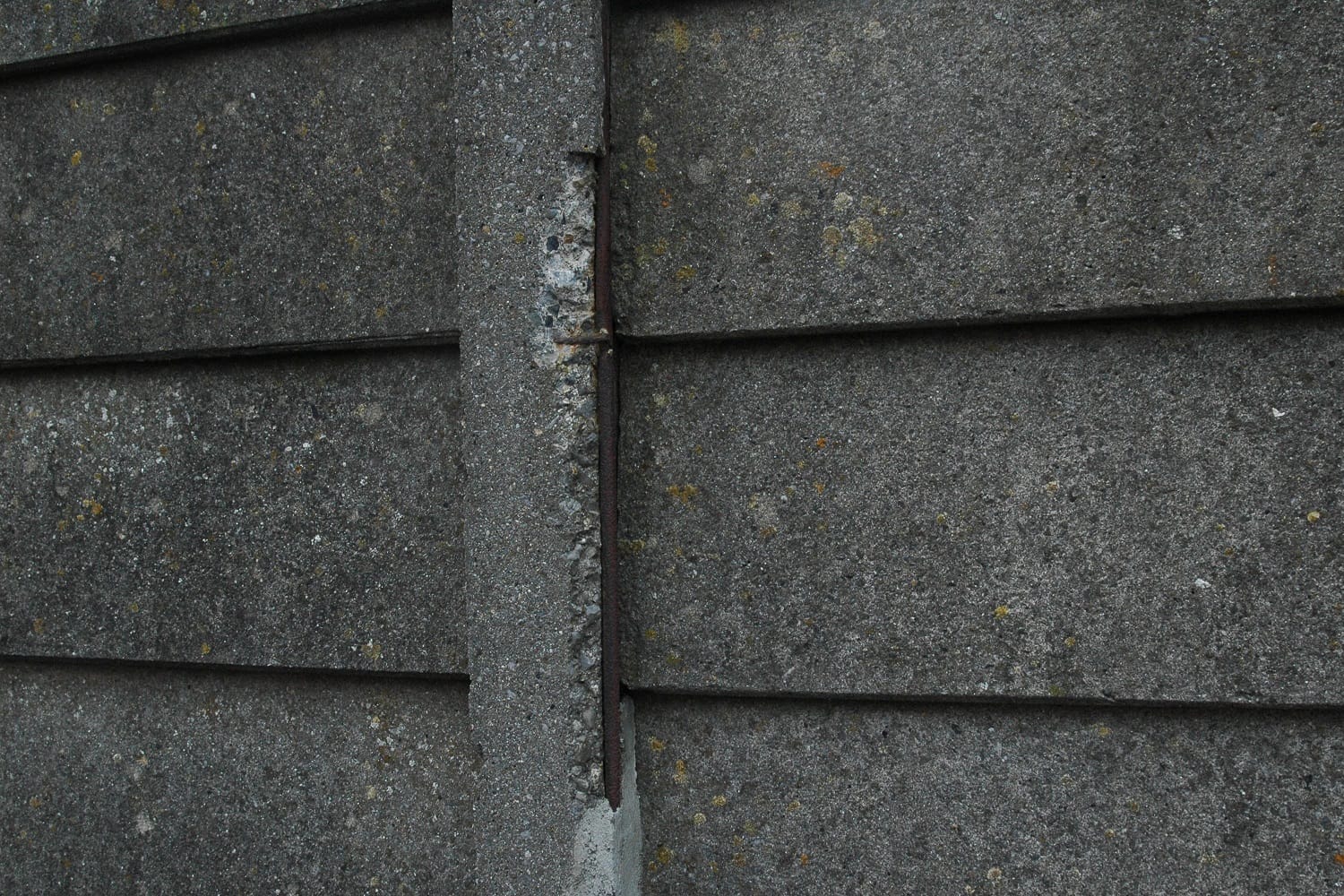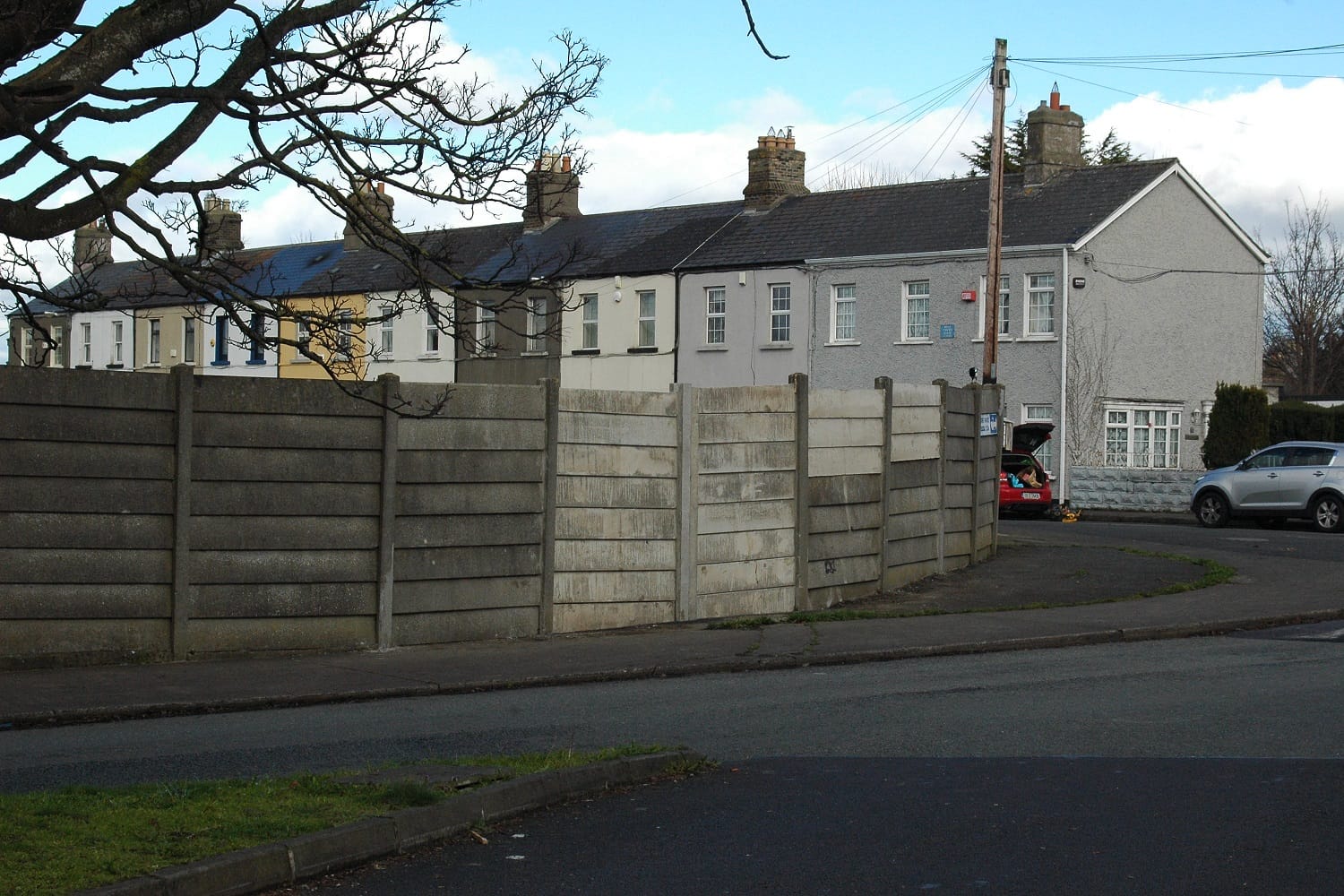What’s the best way to tell area residents about plans for a new asylum shelter nearby?
The government should tell communities directly about plans for new asylum shelters, some activists and politicians say.
A 2021 report said it should urgently be removed and replaced to keep it from collapsing and possibly injuring someone. Some work has been done since then to patch it up.

On Wednesday evening, Deirdre Farrell poked her head out from the window of her home on West Terrace in Inchicore.
Earlier in the day, workmen had been doing piecemeal repairs on the nearby concrete wall around the perimeter of the football pitch behind the CIÉ Hall, she said over the sound of her dog’s barks.
“They did it in the morning.”
The local historian pointed down to a yellow skip stationed by the community centre. Beside it was a stack of removable steel fences.
Made up of concrete posts and horizontal panels, the large wall runs along West Terrace, Inchicore Parade and a gravelly car park. And it appears in poor shape.
Panels are cracked. The concrete on several posts has deteriorated, exposing the corroded steel bar reinforcements. Weeds have grown over the wall, and through several of the panels.
In November 2021, a civil and structural engineering consultancy, Alan Clarke and Associates, warned that the wall had deteriorated significantly.
“Urgent action is required in relation to the condition of the wall around the full perimeter of the pitch in order to prevent the collapse of sections of the wall,” says the engineers’ report.
“A collapse could occur due to the failure of some of the concrete wall panels, the collapse of the decayed concrete posts or a combination of both of these scenarios,” it says.
The only viable solution would be to remove and replace the existing wall, the consultant’s report said. “Due to the weight of the concrete elements, a collapse would present a risk of serious injury or loss of life.”
However, some work has been done since then. After an inspection, Dublin City Council’s dangerous buildings department concluded that while the fencing is in poor condition, it was “not dangerous within the meaning of the Local Gov. Sanitary Services Act 1964 (as amended) within which Dangerous Buildings operate,” said a council spokesperson.
On West Terrace, a large square chunk has come off one panel along the wall, and has been sealed over on the pitch-side by a plastic covering.
The walls are between 2.2 metres and 2.5 metres high around the perimeter, blocking the football pitch on the other side.
But only partly. The grassy field is visible through several holes in between the broken panels.
“Pieces would fall off from time-to-time,” says Mary Flood, one local resident.
When exactly the structure was erected is unclear, the consultancy report says. It is at least 45 years old, Flood says.
Flood calls herself a “blow-in”, while seated in her living room last Thursday afternoon. She moved into the area roughly 45 years ago, she says, and the wall pre-dates her arrival.



It was the residents’ association of the Inchicore Works Estate who asked Alan Clarke and Associates to look at the boundary wall.
An engineer did a visual survey, the report says, noting that they couldn’t access the pitch area to see the wall from that side.
Since its original construction, the precast concrete had suffered from significant deterioration, it said. “The precast panels are in a dangerous condition in places and there is a significant risk of collapse of the panels in a number of locations.”
In certain places, there was little or no protective concrete cover to the reinforcements, it said. “Mechanical damage to the panels was also observed throughout resulting in cracked or broken panels and missing sections of panels in some locations.”
Some of the panels had been previously removed and replaced, it said, with extensive buckling and cracking being evident on panels too.
Damage and the loss of concrete from the post sections had resulted in a considerable loss in their strength, the report said.
In the absence of significant remedial or strengthening works, a collapse of some posts is inevitable, it said. “It is not possible to predict when such a collapse will occur, however this is considered to be an immediate and significant risk to public safety,” it says.
The consultant’s report concluded that given the age and current condition of the structure, the only viable solution will be the removal of the existing wall and to replace it.
No member of the residents’ association of the Inchicore Works Estate agreed to speak about the wall.
In September 2022, Dublin City Council’s dangerous buildings section carried out an inspection on the site, a council spokesperson says.
The fencing was found to be in poor condition, they say. However, the inspectors have deemed it “not-dangerous” inside the definition of the amended Local Government Services Act of 1964, they said.
The council has been in an ongoing engagement with Córas Iompair Éireann (CIÉ), they say. But “remediation is the responsibility of the owners of the structure”.
A CIÉ spokesperson re-directed the query about the wall to Iarnród Éireann.
Barry Kenny, corporate communications manager for Iarnród Éireann, said the wall is encompassed in a lease to the CIÉ Athlete Union.
The wall is explicitly the responsibility of the union, Kenny says, which is a separate entity to both CIÉ and Iarnród Éireann.
“As a gesture of goodwill, both CIÉ and Iarnród Éireann did assist the Athlete Union in remedial works on a three-phase basis over the past 12 months,” he says, “and subsequent engagement with Dublin City Council has confirmed that the structure is completely safe.”
The CIÉ Athlete Union was formed in 1929. It was originally known as the Great Southern Railway Athletic Union.
It consisted of Iarnród Éireann employees who leased the grounds from the company for a small amount of money over a long period of time, says Martin Mitchell, a manager of the Iarnród Éireann football team. “That athletic union is no longer in place.”
The members of the CIÉ Athlete Union are elderly men now, he says. “Unfortunately, a couple of them have passed on.”
In the absence of a football team, the pitch was leased out to local clubs, Mitchell says, including Colepark United, which folded in December 2021.
Get our latest headlines in one of them, and recommendations for things to do in Dublin in the other.